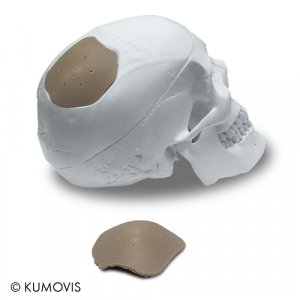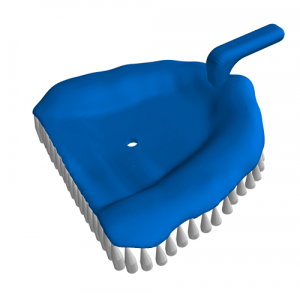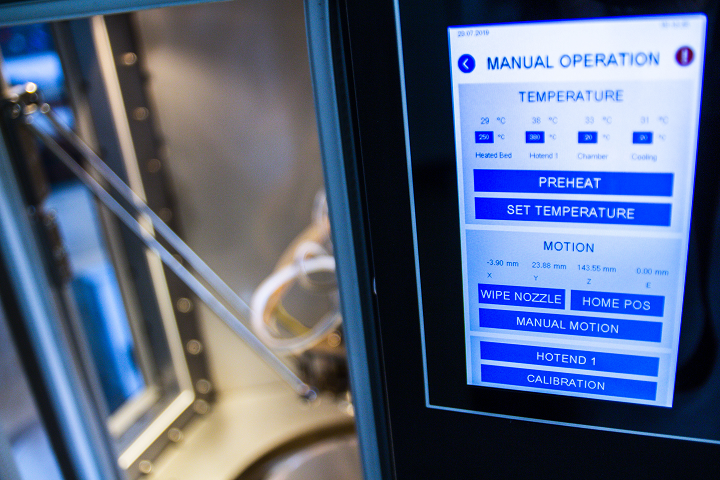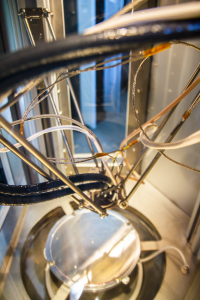Munich-based startup Kumovis GmbH is focused on making 3D printers that can fabricate individualized medical performance from high-performance plastics, such as PEEK. It launched a medical high-temperature FDM 3D printer last year, with plans of commercialization in 2020. Now, Kumovis has announced that its first production 3D printer, with innovative clean room integration, has gone into series production.
The industrial Fused Layer Manufacturing (FLM) R1 3D printer features an integrated temperature control and filter system, so that users can achieve a clean room environment right in the build chamber; this allows the R1 to meet the exacting requirements for making patient-adapted medical products.
Kumovis co-founder Stefan Leonhardt said “With the Kumovis R1, we are excited to provide medical technologists with a resource-efficient additive manufacturing system that meets their high requirements, and what is more, leads FLM processing of high-performance plastics to industrial maturity.
“In addition, with partners such as the software experts from Hyperganic, we will be able to provide rapid access to individualized medical products, and consequently help creating added value for patients and doctors alike.”
Since it was first founded, Kumovis has counted process optimization and reliability as major priorities. The startup creates 3D printers that are tailored specifically to the requirements of regulated markets, such as medical technology. Its main focus is on FLM 3D printing of high-performance plastics like PEEK, which has already made a name for itself in 3D printed healthcare. Now, its new R1 3D printer allows users, like medical technicians, to create high-quality 3D printed implants and other medical products in an efficient, economic, and sustainable way.
The new Kumovis R1 features a patented temperature management system, which allows the build chamber to be homogeneously heated up to 482°F; this can help improve layer adhesion in the print. With an optional filter, the printer’s build chamber can also be turned into a clean room, which helps stop foreign particles from causing defects. All of the systems for comprehensive monitoring in the printer are integrated, which makes the process itself highly reliable and ensures both safety and good documentation.
 The printer also has a software-based print control called Hyperganic Print, which is the printer operating system of German software company Hyperganic, founded in 2015. This print control system makes it possible for users to optimize all prints for a part, and its interface ensures customers have an easy time customizing and automating their processes.
The printer also has a software-based print control called Hyperganic Print, which is the printer operating system of German software company Hyperganic, founded in 2015. This print control system makes it possible for users to optimize all prints for a part, and its interface ensures customers have an easy time customizing and automating their processes.
“Hyperganic works closely with printer manufacturers to enable far-reaching innovations,” stated Hyperganic’s managing director Lin Kayser. “From the beginning, I have been impressed by the vision of the Kumovis founders to reinvent additive manufacturing for medical applications through new materials and advanced process technology. We are convinced of that and look forward to intensifying our collaboration with them.”
 The Hyperganic Print system gives users a high granular control of both material and process parameters for mass production of functional parts. In addition, its design software platform makes it possible to build and structure extremely complex 3D parts.
The Hyperganic Print system gives users a high granular control of both material and process parameters for mass production of functional parts. In addition, its design software platform makes it possible to build and structure extremely complex 3D parts.
Whether Kumovis was working on product orientation, print preparation, or technical support, it has kept medical applications and procedures in the forefront during the whole development process. Another example of this is the Kumovis R1 3D printer’s local cooling system. To make implants fit more adaptively, which improves the patient healing process, you need good reproducible mechanics, as well as dimensional accuracy. The cooling system, which is enabled by Hyperganic software and Kumovis hardware, helps ensure an adaptive fit every time.
- R1 build chamber exterior
- R1 build chamber interior
Three Kumovis R1 3D printers are already being used by pilot customers. It is available for purchase, either as a subscription model or through direct sales.
Discuss this story and other 3D printing topics at 3DPrintBoard.com or share your thoughts in the Facebook comments below.
[Images: Kumovis]Subscribe to Our Email Newsletter
Stay up-to-date on all the latest news from the 3D printing industry and receive information and offers from third party vendors.
You May Also Like
Further Understanding of 3D Printing Design at ADDITIV Design World
ADDITIV is back once again! This time, the virtual platform for additive manufacturing will be holding the first-ever edition of ADDITIV Design World on May 23rd from 9:00 AM –...
3D Printer Maker EVO-tech Reborn as NEVO3D — Once More With Feeling
EVO-tech was a 3D printing service and original equipment manufacturer established in 2013 and based in Schörfling am Attersee, Austria. The company produced high-quality material extrusion systems featuring linear bearings,...
3D Systems Brings 3D Printed PEEK Cranial Implant to the U.S. with FDA Clearance
For more than 10 years, 3D Systems (NYSE:DDD) has worked hand-in-hand with surgeons to plan over 150,000 patient-specific cases, and develop more than two million instruments and implants from its...
CDFAM Returns to Berlin for Second Annual Symposium
The second CDFAM Computational Design Symposium is scheduled for May 7-8, 2024, in Berlin, and will convene leading experts in computational design across all scales. Building upon the first event...



































